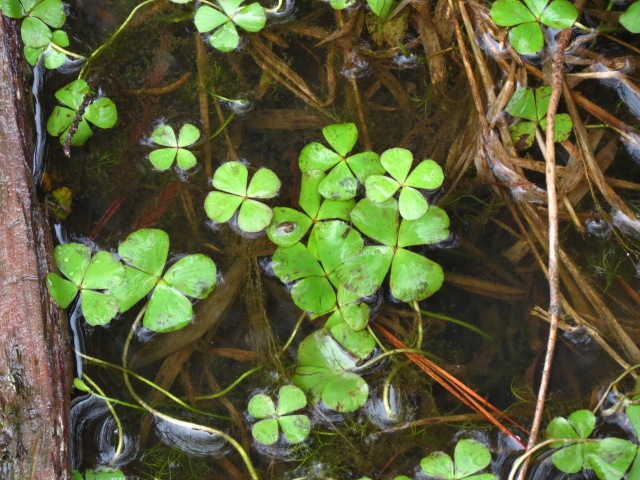Floating near the shore in a suburban lake in Wake County, North Carolina, is a colony of plants that look very much like a group of flooded shamrocks. They are Marsilea quadrifolia, an aquatic fern commonly called European Water Clover or Water Shamrock. Marsilea quadrifolia is an exotic fern, introduced from Europe. It is well established in the Northeast, but is rare in the Southeast. Below is a small group of plants floating at the surface of the water, and a close up of a single plant.
Marsilea quadrifolia is considered a Waif in North Carolina (Weakley’s Flora, May, 2015). A Waif in botanical terms normally refers to an introduced, alien plant that is unable over time to sustain a persistent population, and therefore does not become naturalized. Thus it does not appear on the Flora of the Southeast distribution map for North Carolina or its surrounding states, but has evidently been seen in North Carolina sometime in the past.
As seen in the photos below, the lake provides a stable habitat, with shallow, quiet waters where the plant can root in mud and sand, relatively undisturbed by water level fluctuations. The two trees in the immediate background of the first photo are Bald Cypress (Taxodium distichum).
When the water is shallow enough, the plants can stand erect, out of the water. Note the fiddlehead (a fern’s curled frond) near the center of the picture.
In suitable habitats, the plants also have a land form, erect in the mud or sand. See below.
Marsilea quadrifolia is a popular aquarium and water garden plant. Its sudden appearance in a lake or pond is usually attributed to an accidental or deliberate introduction. It has also been known to be disseminated by waterfowl.
Aquatic ferns represent only a tiny and comparatively insignificant portion of the aquatic plants in the Eastern U. S. Two other aquatic ferns have been described in North Carolina. Azolla caroliniana , the Eastern Mosquito Fern, is a tiny, native, floating aquatic fern, uncommon but widespread in the Southeast. Salvinia molesta, called Giant Salvinia, is considered an exotic noxious weed, and is rare in the Southeast.
Herb Amyx
All photographs were taken on December 26, 2015. Hard freezes and ice in January disrupted the plants and left only bits of debris. The roots are cold hardy and the plants should return in the spring.






